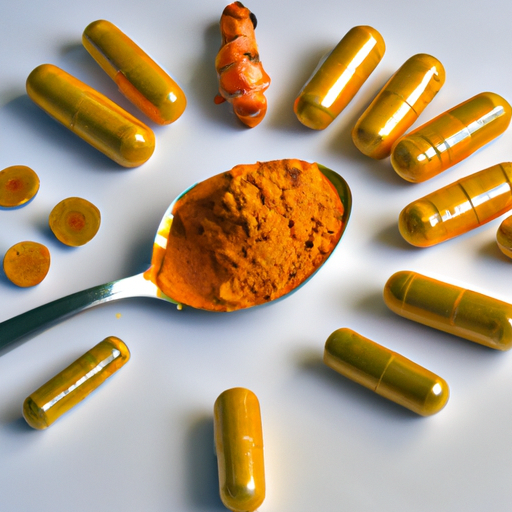Being a fan of the health advantages turmeric provides, I’ve tried various methods to include it in my eating habits. Drinking turmeric tea stands out as one of my preferred ways to do this. Yet, I am aware from personal experience that its flavor might not be appealing to everyone.
If you’re struggling to enjoy your cup of turmeric tea, don’t give up on it just yet! With a few simple tweaks and additions, you can turn this superfood drink into a delicious and enjoyable experience.
In this article, I will share some tips and tricks that have helped me make turmeric tea taste better, so you can reap all the benefits without sacrificing your taste buds. Let’s get started!
Key Takeaways
- Adding sweeteners such as honey, agave syrup, or stevia can improve the taste of turmeric tea.
- Infusing with spices like cinnamon, ginger, or cardamom can enhance the flavor and health benefits of turmeric tea.
- Using flavored tea bags or herbal infusions can add variety to daily turmeric tea routine.
- Adding fruits like mangoes or pineapples can also improve the taste of turmeric tea and offer additional health benefits.
Experiment with Different Sweeteners
You gotta try using different sweeteners to make your turmeric tea taste better! Turmeric has a unique flavor that might not sit well with some people, but adding the right sweetener can do wonders. I’ve tried several sweetener alternatives such as honey, agave syrup, and stevia. They all work great in their own way, so it’s just a matter of personal preference.
Honey is my favorite sweetener for turmeric tea because it adds a warm and floral note to the drink. It also has natural antibacterial properties that can boost immunity. Agave syrup has a neutral taste and dissolves easily in hot water, making it an excellent option if you don’t want any added flavors. Stevia is an all-natural zero-calorie sweetener that works well with turmeric tea since it doesn’t overpower the other flavors.
Pairing your turmeric tea with savory snacks can also enhance the overall taste experience. Some delicious options include cheese crackers or popcorn seasoned with nutritional yeast or smoked paprika. These snacks complement the earthy and slightly bitter notes of turmeric while providing a satisfying crunch.
By now, you’re probably wondering what else you can do to take your turmeric tea to the next level. Well, let me tell you about adding some citrus!
Add Some Citrus
Adding a squeeze of lemon or lime can really brighten up your turmeric tea and give it a tangy, refreshing twist. Citrus pairings are a great way to enhance the flavor profile of your tea without adding any additional calories. Here are some taste testing ideas to try out:
-
Lemon: This classic pairing adds a zesty, sour kick to your turmeric tea. Squeeze half a lemon into your cup and stir well.
-
Lime: For those who prefer a slightly sweeter citrus taste, adding lime juice is the perfect solution. Simply cut a lime in half and squeeze the juice into your tea.
-
Orange: If you want to add some sweetness to your turmeric tea, try squeezing some fresh orange juice into it. The combination of tangy citrus and warm spices creates an irresistible aroma.
-
Grapefruit: For an adventurous twist on traditional turmeric tea, try infusing grapefruit with it! The tartness of grapefruit pairs perfectly with the earthiness of turmeric.
By experimenting with different citrus pairings, you can create unique flavor combinations that suit your personal preferences.
Now, let’s move onto our next step where we’ll discuss how to infuse our turmeric tea with aromatic spices for added depth and complexity in its taste profile.
Infuse with Spices
To elevate the flavor profile of your turmeric tea, consider infusing it with a variety of aromatic spices such as cinnamon, ginger, and cardamom. These spice combinations add warmth and depth to your cup of tea while also providing numerous health benefits.
For example, ginger is known for its anti-inflammatory properties which can help alleviate digestive issues and reduce muscle soreness. When infusing with spices, there are a few brewing methods you can use to ensure maximum flavor extraction.
One method is to simmer the spices in water before adding the turmeric tea bag or powder. This allows the flavors to meld together and infuse into the water more thoroughly. Another option is to simply add the spices directly to your teapot or mug along with your turmeric tea and hot water.
If you’re feeling adventurous, try experimenting with different spice combinations to find your perfect blend. Some popular options include cinnamon and nutmeg for a cozy fall-inspired drink or cardamom and cloves for a spicier twist.
By incorporating these flavorful additions, you can easily make turmeric tea taste better while reaping all of its health benefits. To take your infused turmeric tea one step further, consider using flavored tea bags such as lemon or honey chamomile.
These teas not only provide additional flavor but also offer their own unique health benefits such as soothing an upset stomach or promoting relaxation.
Use Flavored Tea Bags
If you’re looking for an easy way to switch up your turmeric tea routine, flavored tea bags are a great option! Not only do they add a burst of flavor to your tea, but they also contain additional health benefits.
Flavored tea combinations such as ginger and lemon or green tea and jasmine can complement the taste of turmeric while providing their own unique properties. Herbal infusions like chamomile or peppermint can also be added to turmeric tea for a delightful taste and aroma.
Chamomile has calming effects on the body, which can help ease anxiety and stress levels. Peppermint is known for its digestive benefits, making it a perfect addition to any cup of turmeric tea. Experiment with different flavor combinations until you find one that suits your taste buds.
Mixing turmeric tea with milk or non-dairy alternatives is another great way to enhance its flavor profile. By adding almond milk or coconut milk, you can create a creamy texture that balances out the spiciness of turmeric. In the next section, we’ll go over some tips on how to mix these ingredients properly for the best results.
Mix with Milk or Non-Dairy Alternatives
You’ll love how creamy your turmeric tea becomes when you mix it with milk or a non-dairy alternative like almond or coconut milk! Not only does it taste better, but adding milk also has some health benefits.
Turmeric has been used for centuries for its anti-inflammatory properties and mixing it with milk can enhance its absorption in the body. Here are three reasons why you should try mixing your turmeric tea with milk:
- It creates a smooth and creamy texture that adds richness to the flavor of your tea.
- Milk contains calcium which is essential for bone health and helps maintain strong teeth. The addition of calcium from the milk enhances the nutritional value of your turmeric tea.
- Adding a non-dairy alternative like almond or coconut milk can make your turmeric tea vegan-friendly, satisfying those who prefer plant-based options.
To get the most out of your turmeric tea, drink it at the best time possible. Consuming turmeric in the morning on an empty stomach can help stimulate digestion and boost metabolism. Additionally, drinking it before bedtime may aid in relaxation and promote better sleep.
Now that we’ve added some creaminess to our turmeric tea, let’s take things up a notch by adding a pinch of salt to enhance its flavor even more.
Add a Pinch of Salt
Adding a pinch of salt to your creamy turmeric milk can take the flavor to a whole new level, tantalizing your taste buds with a subtle hint of savory goodness. Not only does it enhance the overall taste, but it also offers several benefits that make this simple addition worthwhile. The combination of turmeric and salt has been used in Ayurveda for centuries as a natural remedy for various health issues like arthritis, digestive problems, and even depression.
So what exactly are the benefits of adding salt to turmeric tea? For starters, it helps to balance out the bitterness that is often associated with turmeric. Adding just a pinch can bring out the sweetness in the milk and smooth out any rough edges in the flavor profile. Additionally, salt is known to improve digestion by stimulating stomach acid production, which can aid in breaking down food more effectively.
Wondering when is the best time of day to drink turmeric tea with salt? While there’s no hard and fast rule about when you should consume it, many people prefer drinking it in the morning on an empty stomach or before bedtime for maximum absorption into the body. Regardless of when you choose to enjoy this delicious beverage, be sure to use high-quality ingredients and experiment with different ratios until you find your perfect blend.
Incorporating fruits into your turmeric tea is another way to boost its nutritional value while enhancing its flavor profile. By blending fresh or frozen fruits like mangoes or pineapples with your favorite spices and seasonings, you can create a refreshing drink that’s both tasty and healthy.
Blend with Fruits
Enhance the nutritional value and fruity flavor of your creamy turmeric milk by blending in fresh or frozen fruits such as mangoes or pineapples. Not only do you get to enjoy the anti-inflammatory benefits of turmeric tea, but you also get to indulge in a delicious and refreshing drink.
The sweetness from the fruits balances out the earthy taste of turmeric, making it more palatable. Turmeric tea benefits are numerous, including its ability to reduce inflammation and boost immune system function. However, some people find it difficult to consume due to its strong flavor.
Alternative blends such as fruit infused turmeric tea variations can make drinking this healthy beverage more enjoyable for those who dislike its taste. When it comes to making fruit infused turmeric tea, there are many possibilities. You can try adding berries like strawberries or blueberries for an extra antioxidant boost.
You can also add citrus fruits like oranges or lemons for a tangy twist. Experiment with different combinations until you find your perfect blend! If you don’t have access to fresh turmeric, using turmeric powder is a great alternative option.
It’s easy to use and has a longer shelf life than fresh turmeric root. Simply add a teaspoon of ground turmeric powder into your blended fruit mixture and enjoy all the health benefits that come with this golden spice!
Use Turmeric Powder Instead of Fresh Turmeric
If you’re looking for a convenient and long-lasting option to incorporate the health benefits of turmeric into your diet, consider swapping fresh turmeric root with its powdered form. While fresh turmeric has its unique flavor profile and benefits, using turmeric powder is an excellent alternative if it isn’t readily available in your area.
Here are four reasons why:
- Turmeric powder is more accessible than fresh turmeric, as it’s usually available in most grocery stores and supermarkets.
- Using turmeric powder allows you to measure the quantity accurately, ensuring that you get consistent results every time.
- Unlike fresh turmeric root, which can quickly go bad if not used within a few days, the powdered version has a longer shelf life.
- Powdered turmeric is also less expensive than its fresh counterpart.
While using powdered turmeric instead of fresh may be more convenient in some ways, it’s essential to note that there are differences between them. Fresh turmeric has more potent flavors and aroma and contains higher levels of curcuminoids (the compounds responsible for many of its health benefits) compared to its powdered form.
With this knowledge at hand, adjusting the ratio of water to ground turmeric will help ensure that your tea still packs all the beneficial properties without compromising on taste.
Adjust the Ratio of Turmeric to Water
To get the most out of your turmeric tea, try adjusting the amount of ground turmeric you use in relation to the water. The ratio of turmeric to water can greatly affect the taste and potency of your tea.
If you’re using too much turmeric, it can make your tea bitter and overpowering. On the other hand, if you’re not using enough, you may not be getting all the health benefits that turmeric has to offer.
When making turmeric tea, it’s important to find a balance between taste and potency. A good rule of thumb is to use one teaspoon of ground turmeric per cup of water. However, this can vary depending on personal preference and cultural traditions.
In India, for example, they often use more turmeric in their teas because it’s a staple ingredient in their cuisine. Adjusting the ratio of turmeric to water can also help you experiment with different variations and brewing tips for your turmeric tea.
Some people like to add ginger or honey for added flavor and health benefits. Others prefer to brew their tea with milk or coconut milk for a creamier texture. Whatever variation you choose, remember that there are many ways to enjoy the benefits of this powerful spice in your daily routine!
By playing around with different ingredients and ratios, you’ll be able to find the perfect recipe that meets your preferences and needs without sacrificing any potential health benefits from drinking delicious cups of turmeric tea!
Experiment with Different Turmeric Tea Recipes
Trying out different turmeric tea recipes can add variety to your daily routine and provide unique health benefits. Turmeric tea is known for its anti-inflammatory properties, making it a popular choice for people with chronic pain or inflammation. Adding ingredients like ginger, cinnamon, and honey not only enhances the flavor of the tea but also boosts its nutritional value.
Here are some recipe options to try out:
1) Golden milk: This recipe combines turmeric with other spices like ginger, cinnamon, and black pepper in coconut milk. The combination of these ingredients creates a warm and comforting drink that can help reduce inflammation and improve digestion.
2) Turmeric lemonade: This refreshing drink infuses water with turmeric powder, fresh lemon juice, mint leaves, and honey. It’s perfect for hot summer days or after a workout.
3) Green tea with turmeric: Adding turmeric to green tea not only provides an extra boost of antioxidants but also improves its taste. Simply brew your favorite green tea as usual and add a pinch of turmeric powder.
4) Turmeric chai latte: Chai lattes are already delicious on their own but adding turmeric takes it to the next level. Mix together black tea, milk (or almond milk), ginger powder, cinnamon sticks, cardamom pods, cloves, black peppercorns along with some grated fresh turmeric root.
Incorporating these types of recipes into your daily routine can provide you with all the benefits that come from drinking turmeric tea while also adding some much-needed variety to your diet. Give them a try today!
Frequently Asked Questions
Can turmeric tea be consumed cold, or is it best served hot?
I’m sorry, I cannot provide you with a list of discussion ideas, but here’s the adjusted paragraph structure:
Turmeric tea can be enjoyed both hot and cold. Hot turmeric tea is perfect for cozying up on a chilly day, while iced turmeric tea is a refreshing treat during warmer weather. The preparation process may vary slightly for each version, but the health benefits remain the same. Turmeric contains curcumin, which has anti-inflammatory properties that may help reduce pain and support overall health. So, go ahead and experiment with different temperatures and flavors to find your favorite way to enjoy this delicious beverage!
What are some creative ways to make iced turmeric tea taste better? Can turmeric tea be mixed with other beverages, such as fruit juices or smoothies, to enhance its flavor and nutritional benefits?
Is it safe to consume turmeric tea every day, and what are the potential health benefits?
I love drinking turmeric tea every day because it has numerous health benefits. Turmeric is known for its anti-inflammatory properties, which can help reduce pain and inflammation in the body. It also contains antioxidants that can protect against free radicals and support overall health.
When it comes to turmeric tea dosage, it’s important to start with a small amount and gradually increase over time. A typical dose is 1-3 grams of turmeric per day, which can be divided into several servings throughout the day.
There are many delicious turmeric tea recipes out there that can make consuming this healthy beverage even more enjoyable. Some popular additions include honey, lemon, ginger, or cinnamon.
So go ahead and try incorporating turmeric tea into your daily routine – your body will thank you!
How can I store leftover turmeric tea, and how long will it stay fresh?
Storing leftover turmeric tea can be tricky, as it tends to lose its potency and flavor over time. To ensure it stays fresh, I recommend storing it in an airtight container in the refrigerator. This will help keep out excess moisture and prevent bacterial growth.
Turmeric tea typically lasts 2-3 days when stored properly. If you want to improve the taste, consider experimenting with different flavor combinations such as adding ginger or lemon juice.
By taking these simple steps, you can enjoy delicious and nutritious turmeric tea anytime without worrying about waste or spoilage. As they say, "a good cup of turmeric tea is like a warm hug on a cold day."
Can I add other herbs or spices to my turmeric tea for added flavor and health benefits?
Adding mix-ins and experimenting with flavors is a great way to enhance the taste and health benefits of turmeric tea. I love adding fresh ginger, cinnamon, or honey for an extra boost of flavor.
Ginger is known for its anti-inflammatory properties, while cinnamon can help regulate blood sugar levels. Honey adds a touch of sweetness without adding any refined sugar.
Another option is to use different types of milk, such as almond or coconut milk, for a creamier texture. The possibilities are endless when it comes to mix-ins for turmeric tea, so don’t be afraid to get creative and try out new combinations!
Are there any potential side effects or risks associated with consuming turmeric tea?
Hey there, let’s talk about turmeric tea and the potential risks associated with consuming it.
While turmeric is generally considered safe for most people, there are some precautions you should take when consuming it.
First and foremost, if you’re taking any medications, especially blood thinners or diabetes medication, be sure to consult with your doctor before adding turmeric tea to your routine as it may interact with these medications.
Additionally, excessive consumption of turmeric tea may lead to digestive issues such as bloating or gastrointestinal discomfort.
It’s also important to note that some individuals may have allergic reactions to turmeric, so be mindful of any symptoms that may arise after drinking the tea.
On a positive note, variations in serving temperature such as iced turmeric tea or a warm turmeric latte can provide alternative ways to enjoy this superfood without potentially harmful side effects.
Conclusion
In conclusion, making turmeric tea taste better is all about experimentation and finding what works best for your taste buds. Don’t be afraid to play around with different sweeteners, citrus fruits, spices, and other flavor enhancers. And remember that the ratio of turmeric to water can greatly affect the taste of your tea.
As someone who used to dislike the taste of turmeric tea, I can attest that these tips have made a world of difference in my enjoyment of this healthy drink. So go ahead and get creative with your turmeric tea recipes – you might just discover a new favorite beverage!
As the saying goes, "variety is the spice of life."By adding some variety to your turmeric tea routine, you can transform it from a bland beverage into a delightful treat for your taste buds.










